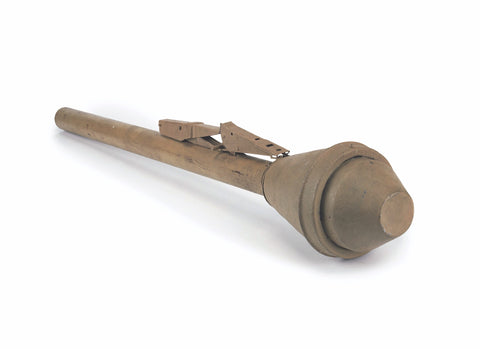
Panzerfaust: The Last-Ditch Weapons of the Nazis
The Panzerfaust is popularly associated with being a last-ditch weapon, wielded by the old men and young boys of the Volkssturm in the final days of the Third Reich. Yet by the end of the war, 8.3 million of these cheap, hand-launched tank-killers had been produced, and between September 1943 and May 1945 they accounted for a significant portion of total German armor kills. Development began in 1942. The first iteration was known as the Faustpatrone (“fist cartridge”) or Panzerfaust 30 klein (“armor-fist 30 short”), but subsequent improvements led to the three core variants of the war years: the Panzerfäuste 30, 60 (the most common), and 100. All these types shared a common design layout. Essentially the Panzerfaust comprised a metal tube holding a black powder propellant charge and mounted with a firing mechanism and basic sight.
The charge fired a bulbous warhead to ranges of 30, 60, or 100 meters—the range of each type was denoted in meters in the variant number. The weapon was fired via a simple two-handed grip, and it operated on recoilless principles; it gave almost no recoil but did impart a vicious and dangerous backblast—the official instruction was not to stand fewer than 10 meters (33 feet) behind one being fired. Panzerfäuste had many limitations. Their short range put the operator in serious danger of return fire from both armor and infantry, and the dust kicked up from the backblast easily identified his position. The weapons were not especially accurate, and mechanical malfunctions were common. Yet distributed in the millions, they became a nerve-wracking threat to Allied armor crews, especially in close-quarters urban or wooded terrain. Thousands of Allied armored vehicles fell victim to the Panzerfäuste , and had they been developed earlier in the war and issued to more highly trained soldiers, their impact could have been considerably greater.
Launch tube
The launch tube was about 3 ft. in length and contained the black powder propellant charge; the Panzerfaust 100 had two charges to increase the range of the weapon.
Firing mechanism
The Panzerfaust featured a simple trigger bar on the top of the launch tube; squeezing the trigger ignited a primer that initiated the main propellant charge.
Sight
The Panzerfaust was fitted with a tall flip-up leaf sight, which had to be raised to allow the firing mechanism to operate. The sight had aiming notches cut into it to give various ranges.
Warhead
The angular cut of the shaped-charge warhead was to ensure more efficient detonation and penetration against sloping armor. Warhead weight was between 2.4 and 5.3 lb., and typical armor penetration was 7.8 in.
this article first appeared in military history quarterly
Facebook: @MHQmag | Twitter: @MHQMagazine
